Comparison: How to choose your Hakama
For all Aikidoka, Kendoka and Iaidoka!
Choosing ones Hakama is often a complex decision. Is this your first Hakama or do you have some experience already? Which fabric corresponds best? What kind of finish? What quality at what price? We will try to answer these questions in this article by presenting the different types of fabric, the different finishes, how to choose your size and discussing the price range for each model.

Seido Aizome Cotton Hakama
First of all, we would like to point out that Seido is only offering 100% made in Japan high end equipment. We will therefore focus this guide on traditional Japanese Hakama and not mention some of the modern 'modified' cuts that some other companies in and out of Japan offer.
What kind of Hakama for which martial art
There are basically 4 types of finish, one for Aikido, one for Iaido and Kendo, one for Kyudo and last but not least the famous Nobakama. The Iaido and Kendo Hakama are very similar, so we put them into the same category and compare it with the Aikido Hakama. Because the Nobakama is very special, we will treat it separately.
| Finish | Aikido | Iaido/Kendo | Comments |
|---|---|---|---|
| Color | Navy, Black or White | Navy, Black or White (or striped) |
> In Aikido, only black and navy. > In Iaido/Kendo, the standard is navy or black, but in certain schools women or children also wear white Hakama or Hakama of various colors. |
| Front Straps Length | 400 to 420 cm | 330 to 360 cm | Practitioners whose waist circumference is more than 90~95 cm, require strap extensions. In Aikido, the front straps are tied in the front, in Iaido and Kendo on the back - that is why they are shorter. |
| Back Strap Length | 180 to 200 cm | 180 to 200 cm | Always tied in the front |
| Lines of Stitching on the Straps | 7 lines | 2, 3 or 4 lines | Too many lines of stitching make the straps too rigid and uncomfortable. For Aikido, 7 lines are, however, essential, because the straps are subject to a lot of tension. |
| Koshiita (Back Plate) | Soft (rubber or synthetic leather) | Rigid (plastic) | In Aikido, rigid Koshiita can be dangerous during falls. However, they are more comfortable for Iaido and Kendo practitioners because they provide better support of the back. |
| Koshiita Hera (Plastic Tab) | Without | With or Without | Can be dangerous during Aikido practice because of the falls. Allows to better fix the Hakama for Iaido and Kendo practice. |
This table allows you to know which Hakama suits your practice to begin with. Other options may be possible - we will present them later in this article. But if you still have a doubt, especially concerning the color, only your teacher can tell you, if what you want is accepted in your school.
The Nobakama
The Nobakama, or literally "field Hakama", features a tighter cut of the pant legs and has only 3 folds instead of 5 on the front. This makes the movements of the legs easier - at the expense of the aesthetic. Aesthetics not being the main concern of the field workers, this type of Hakama was soon adopted, also by people executing manual professions, requiring to move in difficult environments.
It also reconciles with the fact that the Samurai wore leggings, or at least wore their Hakama tied up to not be hampered in their movements.

Seido Aikido Nobakama (cotton)
Used In Aikido by master Saito (Iwama Ryu) and still worn today by some of his students and Iwama style practitioners. For practitioners, it improves the ease of movement, and for the teachers, it shows the foot movements when teaching the technical movements (Ashisabaki). The Nobakama, however, is only used by a limited amount of practitioners.
Seido offers a Nobakama Classic Cut in the most popular fabrics: Tetron, Polyester thin and thick, and Cotton Aizome.
The Hakama Cut
Depending on the martial art the Hakama is used for, the cut / length of the front part is different. In Iaido for example it is more suitable to have it shorter to be able to make the step forward when getting up from a kneeling position more easily. In Aikido, it is actually the same, but because the front part of the Hakama is usually tucked inside the belt, it raises the Hakama naturally a few centimeters.

Bottom/Hem of a Seido Hakama
The Hakama Fabrics
The fabric is probably the most delicate point, and many factors come into play: Your personal preferences, your level of practice, how much time you are willing to spend on taking care of your equipment, how important tradition is for you etc. There are quite some questions you need to ask yourself before you can make your choice.
| Fabric | Particularities Advantages | Disadvantages |
Weight (size 27) |
Our Advice |
|---|---|---|---|---|
| Tetron |
- Cheap - Pleats keep well in place over time - Easy to maintain |
Fabric rather dull. | ~1000g |
THE Hakama for daily practice. The best price/quality ratio. |
| Polyester/Linen |
- Ultra light - Pleats keep well in place over time - Easy to maintain - Quick drying |
Although the fabric is very thin and slightly transparent, it is as strong as the Tetron. | ~850g | For practitioners looking for a lightweight fast-drying Hakama. |
|
Thick Polyester (100% Polyester) |
- Shiny - Pleats keep well in place over time - Easy to maintain |
Quite thick and heavy. | ~1200g | Especially recommended for demonstrations. |
| Black/Navy Cotton |
- Heavy - Slightly shiny - Pleats not fixed - Rather difficult to maintain |
The pleats are not fixed, and therefore the Hakama must be neatly folded after use. | ~1200g |
Features the weight and the strength of cotton, but does not fade like Aizome Hakama. For practitioners looking for a heavy and solid Hakama but do not want to deal with the difficult maintenance of a Aizome Hakama. |
|
Cotton Aizome (Indigo #6000) |
- Heavy - Traditional - Very solid |
- Difficult to maintain - Rubs off heavily - Pleats not fixed, has to be folded with care after each use. |
~1250g | For practitioners seeking a solid, heavy, and above all, traditional Hakama and do not mind the difficult maintenance. |
|
Cotton Aizome (Indigo #10000) |
- High-end model - Extra heavy - Traditional - Ultra solid |
~1450g |

Hakama Fabric Comparison
These are the manly used fabrics in the Japanese Hakama manufacturing, corresponding also to the Seido models.
Additional (optional) options for more comfort
When buying a second Hakama, experience will allow you to know the little things that bother you during practice. You will be able to know more precisely what customizations could optimize the fit and your movements or facilitate maintaining your Hakama. Do not hesitate to seek advice from your Dojo colleagues with more experience.
In compliance with the standards described above, there are several types of "fits" and up to some additional options offered by Seido on the following: Seido Hakama.
| Options | Details | Our Advice | Pictures |
|---|---|---|---|
| Strap Extensions | Front or back strap, mainly for a waist circumference of 95+ cm. |
The length of the straps is calculated as follows: Front : 4 x waist size + 60~80 cm Back : waist size + 80~100 cm (For Kendo and Iaido Hakama multiply by 3 because the front strap of the Hakama is tied on the back and not on the front.) **detailed information below this table |

|
| Wide/Narrow Cut | Widening and narrowing of the front part as well as the back plate to fit your body size. | Below 70 cm and above ~100+ cm waist circumference, not only the length of the straps would not be suitable, but the front and rear width of your Hakama either! It is possible, if opting for a customized Hakama, to adapt these parts if you provide your waist size. **detailed information below this table |

|
| Koshiita Height Ajustment | Adjusting the height of the Koshiita corresponding to the belt you wear and how you tie the Hakama. | > For Kendo/Iaido, the Koshiita should be significantly higher than the front part of the Hakama because of the width of the Iaido belt. > On Seido Aikido Hakama, the base of the Koshiita is adjusted to be worn with a classic Judo-type belt and the front of the Hakama can be tucked into the belt by about 2 cm. Adjustment recommended if you wear a wide belt. |

|
| Koshiita Hera (plastic tab) | Adding a plastic tab (Koshiita Hera) that is put into the Obi to keep the Hakama in place. |
> For Iaido/Kendo/strong>, recommended. > For Aikido, not recommended, because it could cause injuries during falls. |

|
| Shortened or Extended Lateral Vents | Lateral vents extension or shortening. | Extending these openings increases the freedom of movement, but this of course supposes the wearing of pants under the Hakama (Kendoka/Iaidoka!) Shortened lateral vents may be of interest for practitioners tying their Hakama particularly low. |

|
| Lateral Reinforcements | Additional piece of fabric sewn onto the opening. | Not a needed option for Kendo or Iaido Hakama, but useful in the practice of Aikido, in which the Hakama undergoes intense strains. |

|
| Hanger Straps | As the name suggests, two loops on the inside of the Hakama to hang it on a Hanger. | A customization particularly "accessory", but certainly useful, especially when you can leave your Hakama on a hanger in the Dojo. |

|
| Stitched Inside Pleats | Stitched pleats on the inside, over their entire length. Invisible on the outside. | Of low interest on Hakama made from synthetic fabric whose folds are fixed with a professional iron, this option can be a good choice for all cotton models, that are naturally more difficult to maintain, featuring folds that quickly fade. This option greatly helps to identify the pleats after practice or washing. |

|
Click on the thumbnails to enlarge
**Concerning the strap extensions and the wide cut option:
The Japanese Hakama size chart is based on the height and average body shape of Japanese practitioners. However, to better fit the need of Western practitioners, Seido chose to adapt the strap length, adding 20 cm to the back and 20 cm to the front strap from size 25.
This results in a total front strap length of 420 cm and 200 cm for the back strap (measured from one end of the strap to the other, including the middle part of the Hakama/back plate).
These measurements correspond to the average body size of Westerners, a waist circumference of 85 cm (women 80 cm and men 90 cm), allowing to tie the Hakama up to a about 95 cm hip/waist circumference. (Resulting in the formula: 85 x 4 + 80 = 420 cm)
If the straps are only about 20 cm short, a strap extension customization is probably sufficient. But if your waist circumference exceeds ~100+ cm, the overall cut of the Hakama is not suitable.
The Koshiita (back plate) is too small, does therefore not properly support the back and makes the Hakama go up, hindering comfortable movement. To counteract this, we suggest a custom wide cut. Adding this option raises the price, but makes a great difference in terms of comfort during practice.
What Size?
The choice of the size first of all depends on the length of your legs, not your entire body height. And how you measure your Hakama length also depends on how and at what level you tie your Hakama. Traditionally, men would tie the Hakama on the hips and women on the waist and therefore, women should generally opt for a longer Hakama.
Finally, it also depends if you prefer a longer or a shorter Hakama. Usually, the Hakama should reach the lateral malleolus (outside ankle bone) as shown in the picture below, but many practitioners prefer it to be longer. Your body size and habits also come into play, and therefore, the size chart below is for guidance only.
All professional workshops in Japan will measure the length of the Hakama from below the straps on the front. We advise you to rely on that measure, not the size chart.
Therefore, the best and easiest way is to take the Hakama of a friend of a similar size to yours, trying it on and measuring the length by adding or subtracting a few centimeters if the model does not fit.
- Aikido Hakama are 2 cm longer on the back than on the front (which makes the back strap 2 cm lower than the front strap) to adjust the fit wearing it above a belt.
- Kendo and Iaido Hakama are 3-5 cm longer on the back, because the Kakuobi (large belt) tied with it, makes the Hakama be worn higher on the back.
| Men's Fit | Hakama Size | Hakama Length | Women's Fit |
|---|---|---|---|
| 150 ~ 155 | 21 | 79 cm | 144 ~ 147 |
| 155 ~ 160 | 22 | 83 cm | 147 ~ 150 |
| 160 ~ 160 | 23 | 87 cm | 150 ~ 154 |
| 160 ~ 165 | 24 | 91 cm | 154 ~ 158 |
| 165 ~ 167 | 24.5 | 93 cm | 159 ~ 162 |
| 168 ~ 170 | 25 | 95 cm | 163 ~ 164 |
| 170 ~ 172 | 25.5 | 97 cm | 165 ~ 166 |
| 173 ~ 175 | 26 | 99 cm | 167 ~ 168 |
| 175 ~ 177 | 26.5 | 100 cm | 169 ~ 171 |
| 178 ~ 180 | 27 | 102 cm | 172 ~ 173 |
| 181 ~ 184 | 27.5 | 104 cm | 174 ~ 176 |
| 185 ~ 190 | 28 | 106 cm | 177 ~ 180 |
| 190 ~ 195 | 29 | 110 cm | 180 ~ 185 |
| 195 ~ 200 | 30 | 114 cm | 185 ~ 190 |

Good to know
The sizes of the Hakama are not decided arbitrarily, but the measurements are actually in an old unit, the "Kujira-shaku". The traditional Japanese unit of measurement is the Shaku (30.3 cm), the Kujira-shaku (literally whale Shaku) can be translated as "long Shaku", used primarily in the production of traditional clothing, even today. It is believed that this term comes from an ancient measurement tool used in the textile industry, made from whale whiskers.
1 Kujira-shaku = 37.88cm
And now, you can do the math: a size 27 refers to 2.7 Kuri-shaku, or in other words: 2.7 x 37.88 cm = 102.3 cm. This is how the Hakama sizes are calculated.
However, be careful with these measures! With very few exceptions, the traditional (and good) Japanese manufacturers comply with this standard, but this is rarely the case when the Hakama are not manufactured in Japan.
What kind of Hakama for what price ?
This might be the part that interests the most: By now, you might have about an idea of what kind of Hakama you would like, what type of fabric mostly corresponds to your needs. So let us have a look at the pricing of these models.
| Model | Specifications | Price |
|---|---|---|
| Keiko Tetron Iaido/Kendo Hakama (Training) | Entirely machine sewn, reinforced lateral vents, Koshiita Hera, durable back plate (plastic), classic Kendo/Iaido cut - Excellent price/solidity ratio. | ** |
| Keiko Tetron Aikido Hakama (Training) | Entirely machine sewn, reinforced lateral vents, hanger straps, soft but durable back plate (synthetic leather), traditional cut - Excellent price/solidity ratio. | ** |
| Tetron Aikido Hakama | Hand sewn, traditional cut, good price/solidity ratio - Perfect for daily training. | ** |
| Lightweight Polyester/Linen Hakama | Hand sewn, light weight, quick drying, good quality/price ratio - Ideal for traveling. | *** |
| Semi-Heavy Weight Polyester "Cashmere Touch" Hakama | Hand sewn, heavy (especially for a synthetic fabric), good quality/price ratio, shiny fabric - Ideal for demonstrations. | *** |
| Heavy Weight (#8000) Black/Navy Cotton Hakama |
Hand sewn, slightly shiny, very heavy and durable. Does not fade - The perfect compromise between a synthetic fabric and Aizome. |
**** |
| Heavy Weight Indigo (Aizome) Cotton Hakama |
Hand sewn, heavy, very durable - THE choice for practitioners seeking tradition above all. Traditional Bushu Aizome dye, does fade heavily during several weeks of practice. |
**** |
Finally
It is essential to use a Hakama designed for the art you practice! Many shops do offer Hakama without knowing what they are for.
The Hakama are carefully designed for a specific practice. Kendo and Iaido Hakama have been existing for over a century in their present form, however, the Aikido Hakama were changed and improved over time by tailors, depending on the requests of the Aikidoka.
So now you understand the reason behind this article! The making of a Hakama is complex, but it is an art that takes seriously into account all the technical aspects of the art for which it is intended.
If you have any question, do not hesitate to leave a comment !

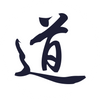
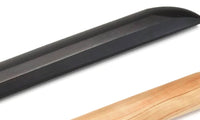
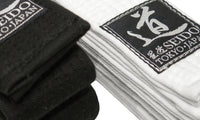





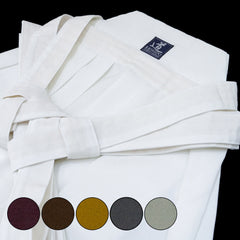
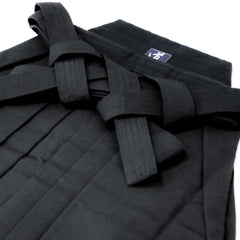

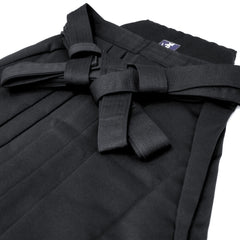
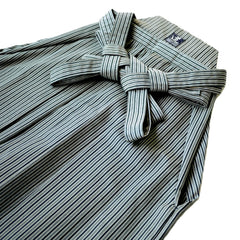
9 コメント - Comparison: How to choose your Hakama
I am interested in ordering a tetron hakama with the low koshiita customization but on your order page it does not show this option for customization. How can I add it to my order?
I would like to know the difference between a Hakama for Iaido and Kyudo. I did not see the comparison in your article.
Thank you for your kind response.
Bob Kasa
Thanks for all the interesting explanations.
Do you have any recommendations concerning Hakama for Chado (tea ceremony), I know that as a women I rather should wear Kimono for official occasions, but for Keiko I would like to wear Hakama because for my eye it looks so beautiful.
Would it be better to wear an Aikido style Hakama or should it be completely different style altogether?
Thanks for any suggestions!
In reply to Diego ferreyra.
Thank you very much for your comment.
For pricing, please check out our website SeidoShop.com
My compliments for the site and for the interesting writings. Could you please explain with a little bit more details the difference between Kyudo hakama and those for other Martial Arts?
With thanks and greetings
Antonello.
In reply to Antonello.
Thank you for your comment.
Because we are not really selling Kyudo-Hakama, and do not have that much experience concerning this topic, we did not want to go into a detailed explanation.
But in short: There are two types of Kyudo-Hakama. One for women and one for men. The men’s cut is similar to that of an Aikido/Iaido Hakama, featuring “two legs” and is called “Uma-Nori” (horse riding) . The women’s cut is rather like a skirt, without the “legs separated”, and without koshiita called Andon (lantern). The fabric is similar to that of other Hakama, usually Tetron, black or blue. They usually feature only 1 line of stitching on the straps, and a cut that takes into account the standing position when shooting an arrow. The Koshiita is usually mad As said before, we are not specialized in Kyudo-Hakama, but I still hope that this gives you a rough idea.
Thanks for the reply. Cheers for now, Antonello
Good morning, could you tell me if a hakama will fit equally a man and woman considering that the woman might have more curves in the hips? The same sizes applies to both genders?
In reply to Myriam cedres.
Hi Myriam,
Thank you very much for your comment.
Actually, the fact that women have usually more curves in the hips is something that is already taken into account in Budo tradition, but rather than changing the cut of the Hakama, it is the way women wear it that is different from the men. Because of that general difference in morphology, women usually and traditionally wear their Hakama higher on the hips than men. They tie it around the waist rather than the hips, which is why they usually require a Hakama longer than the equivalent for a man of the same height.
We explain that difference in the tutorial we made to help people getting the right size of Hakama on YouTube.
Other than this, the cut of the Hakama for men and women is pretty much the same in all martial arts, with maybe the exception of Kyudo, as mentioned in an earlier comment.